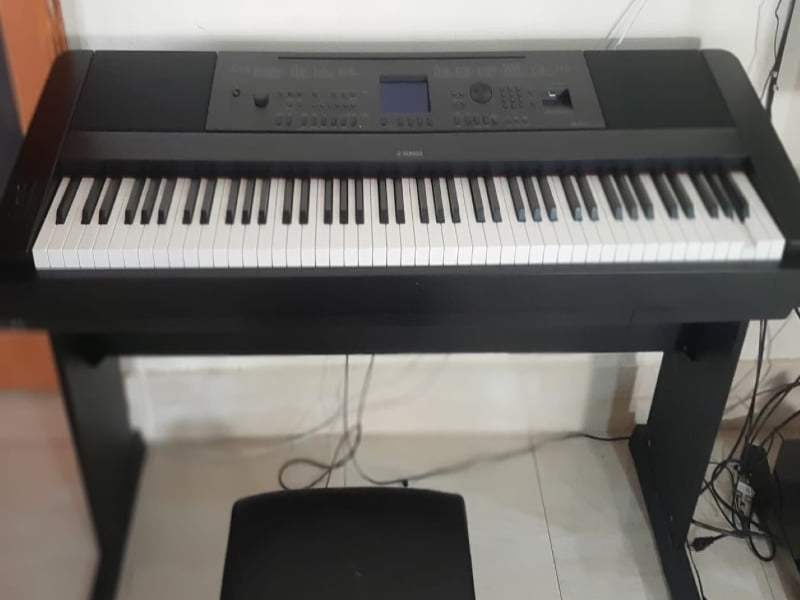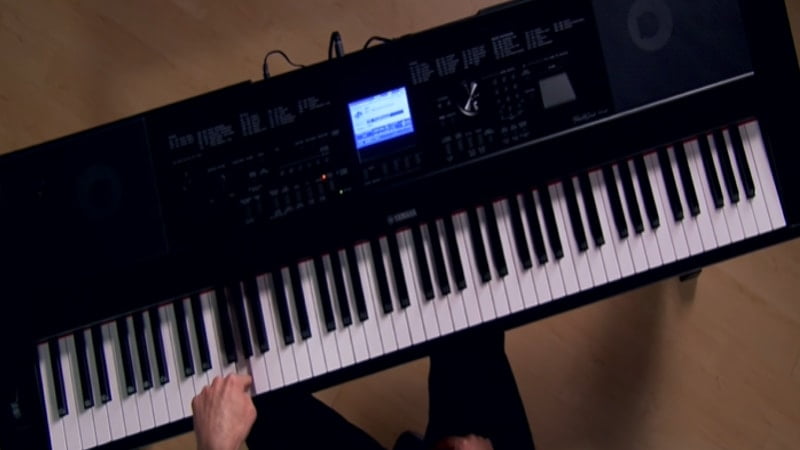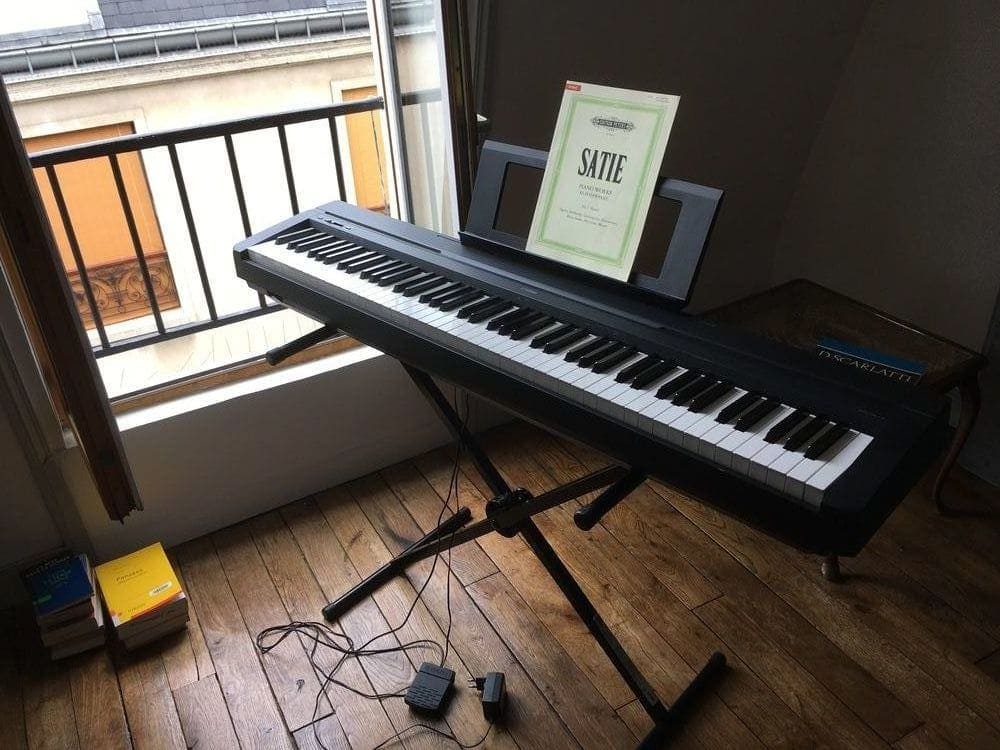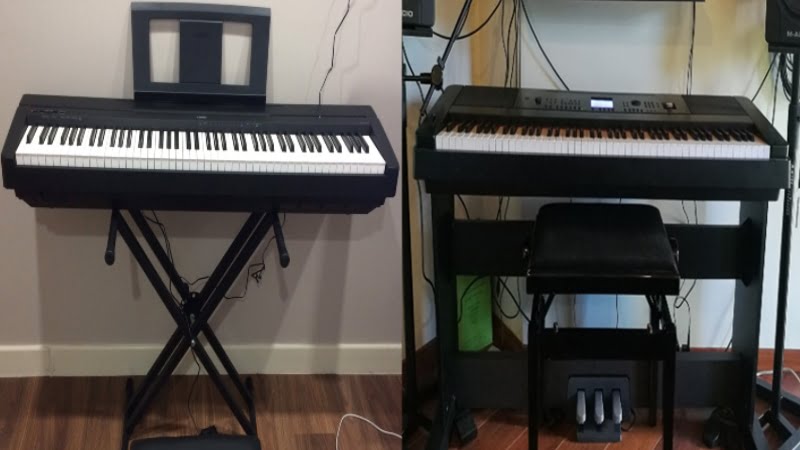These two pianos come from different price ranges, but which one is better? Find out in this Yamaha P45 vs DGX-660 comparison.
It’s easy to assume that the more expensive digital piano is always the better option. But that isn’t always the case. And one of the best examples of this is when you compare the Yamaha P45 vs the Yamaha DGX-660.
Despite being twice the price of the P45, the DGX-660 comes with similar specs and would only be the better piano for specific pianists. If you’re a beginner or novice, I found that the P45 is a great pick, despite being the more affordable option.
That said, when I compared the two, the Yamaha DGX-660 still came out on top. With a better sound engine and more features, it was hard for the P45 to beat the DGX-660.
And if you want to find out which piano is the better pick for you, you’ve found the right article. In this comparison, I get into the details of both pianos and explain why the DGX-660 is more expensive. By the end, choosing the best instrument for your needs will be an easy choice.
Yamaha P45 Vs DGX-660: Comparison Chart


Last update on 2025-07-12 / Affiliate links / Images from Amazon Product Advertising API
Yamaha P45 Vs DGX-660: The Features
I had to find a way to compare these pianos objectively. And I figured the best way to do that was to compare the features directly. That’s how I discovered that the Yamaha DGX-660 has the features to justify its price, making it the clear winner. And when all was said and done, the score was 3-1 in favor of the DGX-660.
In this section, I’ll get into more detail about both pianos. That way, you can see how the P45 actually put up a good fight against the DGX-660.
Tone
The winner: Yamaha DGX-660

For the price, the Yamaha P45 offers a great sound library with rich tones. But as you might expect, the more expensive DGX-660 comes with much more variety and a better sound engine, which is why it won the point in this comparison.
+Sound Library
The Yamaha P45 has a humble 10-voice library. And if you’re a beginner or novice pianist, you won’t need much more. The Yamaha P45 offers various acoustic and electric piano, strings, and organ voices which is a great basic selection.
That said, since the DGX-660 comes with a more advanced tone engine, you can expect more tones. This piano has over 500 different voices. 151 of these voices are premium tones from the Yamaha Pure CF Sound Engine, 15 are drum kits, and 388 are from the XG-lite tone generator.
While not all of the voices on the DGX-660 are premium, it’s still very nice to have all this variety.
+Tone Generation
The Yamaha P45 uses AWM stereo sampling, providing very realistic and rich tones for the price. However, I found that it paled compared to the Yamaha Pure CF Sound Engine, which is the source of many of the voices on the DGX-660.
The Pure CF Sound Engine is the more premium of the two, so the tones are brighter and more realistic. If you’re a beginner, the difference won’t matter that much. But if you’re an experienced pianist, you’ll find that the DGX-660 produces much higher-quality voices.
Feel & Playability
The winner: Tie
The next comparison point was the piano feel. And between the two, I could barely tell the difference. So, I had to declare both pianos the winner in this category.
+Hammer Action
You’ll be surprised to find that both of these pianos use the Graded Hammer Standard. Yamaha uses this system on both affordable and premium pianos because it can produce a very realistic feel at an affordable price.
With both pianos, you’ll notice that the weight of the lower keys is slightly heavier than, the higher keys to mimic the feel of an acoustic piano. That way, the keys feel very realistic and great on your fingers.
Piano Features
The winner: DGX-660
Another important comparison point was the piano features. And when comparing these two pianos, I couldn’t deny that the DGX-660 was better. Even if the Yamaha P45 came with basic effects and decent playing modes, there was much more variety and control with the DGX-660.
+Playing Modes

The better piano for playing modes depends on your needs. The Yamaha DGX-660 has dual and split modes, which are best for performing pianists who want to create unique tone combinations to produce a new sound or fill more sonic space.
Dual mode allows you to blend two voices together, while split mode divides the piano and allows you to assign a different voice on each side. As you might tell, this is great for live performances as it gives you more tonal variety.
On the other hand, the P45 comes with dual and lesson modes. Lesson mode works similarly to split mode, but instead of assigning different voices on each side, both sides have the exact same voice and tuning. That way, you and another pianist can play simultaneously as if you each had your own piano.
This is great for piano lessons and duets. And since both pianos have their own playing modes, it’s important to figure out your own needs before choosing one for your home.
+Effects
It was great to see that the Yamaha P45 came with reverb effects, which are the only effects you will need as a pianist. But to add more versatility, the DGX-660 has chorus, DSP, and master EQ effects, which give you much more control over your tone, and that is why I find the DGX-660 to be the better option for performing pianists.
While it might sound like the DGX-660 is the better pick because it has more effects, keep in mind that you won’t need these effects if you’re a beginner. When starting out, all you really need is reverb. This adds more depth and body to the tone without distracting you from the original piano sound.
The thing about the chorus effect is that it completely warps the sound, which might end up distracting you. On top of that, the DSP and Master EQ effects are designed for trained ears that have played piano for a while. If you aren’t familiar with how to EQ a piano, you might even make your tone worse by experimenting with it.
So, while the DGX-660 has more effects, it would only be useful for experienced pianists. You’re better off with the simple P45 if you’re a beginner.

Yamaha P45 Vs DGX-660: The Similarities
While both of these pianos are in different price ranges, they have their fair share of similarities. To start, they both have glossy plastic keys. While these are cost-effective, they provide a weird feel to the piano, which you will notice if you’re used to textured wooden keys.
While this isn’t a deal-breaker, it’s definitely something you want to know. But since the Yamaha P45 is cheaper, it’s a more understandable flaw. The DGX-660 costs more than $1,000, so you’d expect it to come with a better key texture than cheaper pianos.
Another feature both pianos share is that they’re very portable. That way, you can easily bring them around with you to gigs, piano lessons, or jams with friends. If you’re a serious pianist looking for a top-tier instrument, the DGX-660 is the superior pick. But if all you need is a piano for rehearsals and basic piano lessons, you might find the P45 more worth your money.
Quick Rundown of the Yamaha P45
- Includes the P45 Digital Piano, power adapter, sustain pedal and music rest
- 88 fully weighted piano style keys simulate the feel of an acoustic piano and provide a quality playing experience
- GHS weighted action is heavier in the low end and lighter in the high end, just like an acoustic piano
- Contains 10 different voices, including digitally sampled tones from real Yamaha acoustic grand pianos
- Dual mode lets you combine 2 voices together, like piano and strings, for an inspiring new playing experience. Tuning- 414.8 - 440.0 - 446.8 Hz
Last update on 2025-07-12 / Affiliate links / Images from Amazon Product Advertising API
Quick Rundown of the Yamaha DGX-660
- The Pure CF Sound Engine faithfully reproduces the tone of a meticulously sampled and highly acclaimed Yamaha concert grand piano
- GHS weighted action is heavier in the low register and lighter in the high, just like an acoustic piano
- Score display puts music notation of MIDI songs on the screen, helping you play your favorites by following the bouncing ball
- The Piano room lets you choose from a variety of pianos and acoustic settings to create your own personal piano environment
- The 6 track recorder allows you to capture your performances and song ideas, then add additional layers to spice up your pieces
Last update on 2025-07-12 / Affiliate links / Images from Amazon Product Advertising API
Product Videos
Related Articles to Yamaha P45
- Yamaha P45 vs P45B: What’s the Real Difference?
- Yamaha P45 vs DGX-650: Is the DGX-650 Worth the Higher Price?
- Yamaha P-35B vs P45: Finding the Best Affordable Yamaha Piano
- Yamaha P45 vs Williams Rhapsody II: A Head-to-Head Comparison
- Yamaha P45 Vs NP32: A Head-to-Head Comparison
- Yamaha P45 vs Williams Allegro III: Finding the Best Digital Piano on a Budget
- Yamaha P45 vs YPG 535: Which Is the Best Affordable Yamaha Piano?
- Yamaha P60 vs P45: Finding the Best Yamaha Portable Digital Piano
- Yamaha P45 vs P105: Should You Spend Extra for the P105?
- Alesis Recital Vs Yamaha P45: Which Offers Great Value For Money?
- Donner DEP-10 Vs Yamaha P-45: Which Digital Piano Is Better?
- Yamaha P45 Vs Korg B2: Which Digital Piano Fits Beginners Better?
- Yamaha P45 VS P115: Which P-Series Newbie Gives You More Value for Money?
- Yamaha P45 vs Casio CDP S100: Finding the Better Bet for Beginners
- Yamaha P45 vs YDP 103: Should You Get a Portable or Console Digital Piano?
- Alesis Recital Pro vs Yamaha P45: Which Should You Get As Your First Piano?
- Yamaha P45 vs Roland FP10: Which Entry Level Titan Takes the Top Spot?
- Yamaha P45 vs Donner DEP 20: Which Model Is the Better Option for Beginners?
- Yamaha P45 vs Casio PX 770: Should You Get the Portable or Console Digital Piano?
- Alesis Prestige Artist vs Yamaha P45: Can Alesis Hold Its Own Against the Popular Yamaha Model?
- Yamaha P45 vs P125: Why the Yamaha P125 Is the Better Pick for Pianists
- Yamaha P71 vs P45: Why the Amazon Exclusive P71 is the Better Digital Piano
Related Articles to Yamaha Dgx 660
- Yamaha YDP-164 vs DGX-660: Why You Should Go for the DGX-660
- Yamaha DGX-660 vs Roland FP-90: Why the Roland FP-90 Is the Better Pick
- Yamaha DGX-530 vs 660: Why the DGX-660 Is the Better Pick
- Yamaha DGX-505 vs 660: Why the DGX-660 Is the Better Pick
- Yamaha DGX-660 vs DGX-640: A DGX Comparison
- Yamaha DGX-660 vs DGX-630: A DGX Comparison
- Yamaha DGX-620 vs 660: Finding the Best DGX Model
- Yamaha DGX-660 vs YDP-163: Which Is the Better Piano?
- Yamaha DGX-660 vs Roland Juno DS-88: Which Is the Better Piano?
- Yamaha DGX-660 vs Casio PX-360: Which Is the Better Piano?
- Yamaha DGX-660 vs YDP-144: Which Is the Better Yamaha Piano?
- Yamaha DGX-660 vs Korg Havian 30: Which Is the Better Digital Piano?
- Yamaha DGX-660 vs Casio CGP-700: Which Is the Better Pick?
- Yamaha DGX-660 vs YPG-535: Finding the Best Yamaha Digital Piano
- Yamaha DGX-660 vs P515: Is the P515 Worth the Extra Cost?
- Yamaha DGX-660 vs P-115: Which Yamaha Model Is Better?
- Yamaha DGX-660 vs Casio PX-560: Which Piano Offers More Value For The Money
- Yamaha DGX-660 vs 650: A DGX Comparison
- Korg XE-20 vs Yamaha DGX-660: Finding the Best Digital Piano
- Yamaha DGX 670 Vs 660: The Distinct Difference In Details You Need To Know About
- Yamaha YDP-103 Vs DGX-660: Which Is The Better Yamaha Piano?
- Casio PX-770 Vs Yamaha DGX-660: Should You Get A Portable Or Console Digital Piano?
- Yamaha P71 vs DGX-660: Can the Amazon Exclusive Beat Out the Premium Model?
- Yamaha P125 vs DGX 660 Comparison: Can the P125 Hold Its Own Against the DGX 660?
References:
- Yamaha P45: https://usa.yamaha.com/products/musical_instruments/pianos/p_series/p-45/specs.html#product-tabs
- Yamaha DGX-660: https://usa.yamaha.com/products/musical_instruments/pianos/p_series/dgx-660/index.html
Lulacruza is an electronic folk duo operating at the junction of the hypermodern and the ancient. Our music weaves together hypnotic female singing, South American folk instruments and electronic processing, while channeling pulsating waves from the source of creation.
Lalucruza is also a community where you can connect with other music lovers to collaborate, exchange ideas and share knowledge. A platform for who wants to learns the basics of playing piano, guitar, drum masters’ technique, etc.. is the premise of our website.
